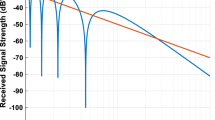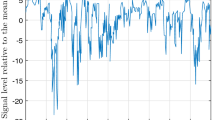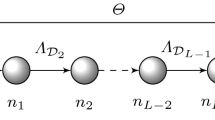Abstract
Information about the spatial mean signal values is used as the control information in many practical aspects of digital communications (e.g. handoff, adaptive coding/modulation). That raises the question: How long the appropriate averaging length \({2L}\) should be in order to enable us to accurately estimate these spatial mean signal values? Lee was the first who gave analytical recommendations for the choice of the averaging length (\({2L}\) should be between \({20 \lambda }\) and \({40 \lambda }\)) and to date, his recommendations are being used as a reference for the averaging process. Although Lee’s recommendations give accurate mean signal estimations in some outdoor environments, the results obtained using Lee’s methodology are not applicable for indoor averaging, due to lack of their consistence with empirically obtained results (\(2L \le 10\lambda \)). Moreover, Lee’s recommendations cannot be used to explain much larger \({2L}\) values adopted in the processes of averaging in suburban/rural outdoor environments (\(2L \approx 100 \lambda \)). In contrast to Lee, who treated multipath variations as a dominant factor that affects the choice of the appropriate averaging length, in this paper it is shown that shadowing variations, beside multipath, play a crucial role in the process of \({2L}\) determination. Thus, considering also shadowing variability, a novel approach in determination of the appropriate mean signal’s averaging length is proposed in this paper. According to herein proposed approach, the appropriate averaging length should be determinated not just as a length at which the multipath is smoothed sufficiently, but also as a length at which shadowing can be considered as a highly correlated process. In contrast to existing analytical results, the results obtained following herein proposed methodology coincide well with all above mentioned empirical results and enable us to unambiguously determine the appropriate values of \({2L}\) for all types of wireless environments (both indoor and outdoor).



Similar content being viewed by others
References
Valenzuela, R. A., Landron, O., & Jacobs, D. L. (1997). Estimation local mean signal strength of indoor multipath propagation. IEEE Transactions on Vehicular Technology, 46(1), 203–212.
Tepedelenlioglu, C., Abdi, A., Giannakis, G. B., & Kaveh, M. (2001). Estimation of doppler apread and signal strength in mobile communications with applications to handoof and adaptive transmission. Wireless communications and mobile computing (pp. 221–242). Hoboken: Wiley.
Vega, D., Lopez, S., Matias, J., Gil, U., Pena, I., Velez, M., et al. (2007). Generalization of Lee method for the analysis of the signal variablity. IEEE Transactions on Vehicular Technology, 58(2), 506–516.
Lee, W. C. Y., & Yeh, Y. S. (1974). On the estimation of the second-order statistics of log normal fading in mobile radio environment. IEEE Transactions on Communications, 22(6), 869–873.
Lee, W. C. Y. (1985). Estimate of local average power of a mobile radio signal. IEEE Transactions on Vehicular Technology, 34(1), 22–27.
Parsons, J. D. (2000). The mobile radio propagation channel (2nd ed., pp. 229–232). Hoboken: Wiley.
Austin, M. D., & Stuber, G. L. (1994). Velocity adaptive handoff algorithms for microcellular systems. IEEE Transactions on Vehicular Technology, 43(3), 549–561.
van der Wijk, F., Kegel, A., & Presad, R. (1995). Assessment of a pico-cellular system using propagation measurements as 1.9 GHz for indoor wireless communications. IEEE Transactions on Vehicular Technology, 44(1), 155–162.
Jalden, N., Zetterberg, P., Ottersten, B., Aihua, H., Thoma, R. (2007). Correlation properties of large scale fading based on indoor measurements. In Proceedings on wireless communications and networking conference WCNC 2007 (pp. 1894–1899). Kowloon.
Gudmuundson, M. (1991). Correlation models for shadow fading in mobile radio systems. Elecrtonic Letter, 27(23), 2145–2146.
Rautiainen, T., Kalliola, K., Juntunen, J. (2005). Wideband radio propagation characteristics at 5.3 GHz in suburban environments. In Proceedings on IEEE 16th international symposium on personal, indoor and mobile communications (pp. 868–872). Berlin.
Njemcevic, P. (2014). Local average signal estimation in nakagami-m channelss. In proceedings on IEEE 6th international symposium on communications, control, and signal processing (pp. 441–444). Athena.
Matias, J.M., Lopez, S., Pena, I., Fernandez, I., Angueira, P. (2008). Location correction factor for coverage planning tools for DRM (Digital Radio Mondiale) in the 26 MHz band. In Proceedings on IEEE international symposium on broadband multimedia systems and broadcasting Las Vegas
Shankar, P. M. (2012). Fading and shadowing in wireless systems. New York: Springer.
Patzold, M., Avazov, N., & Nguyen, V. D. (2011). Design and simulation of measurement-based correlation models for shadow fading. Journal on Electronics and Communications, 1(2), 80–87.
Kostic, I. M. (2005). Analytical approach to performance analysis for channel subject to shadowing and fading. IEE Proceedings Communications, 152(6), 821–827.
Laselva, D., Zhao, X., Meinili, J., Jamsa, T., Nuutinen, J. P., Kyosti, P., Hentila, L. (2005). Empirical models and parameters for rural and indoor wideband radio channels at 2.45 and 5.25 GHz. In Proceedings on 16th IEEE international symposium on personal, indoor and mobile radio communications (pp. 654–658). Berlin.
Mockford, S., Turkmani, A.M.D., Parsons, J.D. (1990) Local mean signal variability in rural areas at 900 MHz. In Proceedings on 40th IEEE vehicular technology conference, Orlando.
Laethem, B. V., Quitin, F., Bellens, F., Oestges, C., & Doncker, P. D. (2012). Correlation for multi-frequency propagation in urban environments. Progress in Electromagnetics Research Letters, 29, 151–156.
Perahia, E., Cox, D.C., Ho, S. (2001). Shadow fading cross correlation between basestations. In Proceedings on 53rd IEEE vehicular technology conference (pp. 313–317). Rhodes: VTC 2001 Springer.
Algans, A., Pedersen, K. I., & Mogensen, P. E. (2002). Experimental analysis of the joint statistical properties of Azimuth spread, delay spread and shadow fading. IEEE Jurnal on Selected Areas in Communications, 20(3), 523–531.
Wang, Z., Tameh, E.K., Nix, A. (2006). Simulating correlated shadowing in mobile multihop ralay/Ad-hoc networks. IEEE 802.16 Broadband Wireless Access Working Group.
Glazunov, A.A., Wang, Y. (2005). Decorrelation distance characterization of long term fading of CW MIMO channels in urban multicell environment. In Proceedings on 18th international conference on applied electromagnetics and communications ICECom 2005, Dubrovnik.
Universal Mobile Telecommunications System (UMTS). (1997). Selection procedures for the choice of radio transmission technologies of the UMTS. European Telecommunications Standards Institute.
Sharma, R.K., Wallace, J.W. (2009). Experimental characterization of indoor multiuser shadowing for collaborative cognitive radio. In Proceedings on 3rd European conference on antennas and propagation, EuCAP 2009, Berlin.
Tanghe, E., Joseph, W., Verloock, L., Martens, L., Capoen, H., Herwegen, K. V., et al. (2008). The industrial indoor channels: Large-scale and temporal fading at 900, 2400 and 5200 MHz. IEEE Transactions on Wireless Communications, 7(7), 2740–2751.
Acknowledgments
I wish to express my appreciation to Prof. Ivo M. Kostic whose involvement, dedication and support made this research possible.
Author information
Authors and Affiliations
Corresponding author
Rights and permissions
About this article
Cite this article
Njemcevic, P. A Novel Approach in Determination of the Appropriate Spatial Averaging Signal Length. Wireless Pers Commun 82, 1851–1861 (2015). https://doi.org/10.1007/s11277-015-2318-1
Published:
Issue Date:
DOI: https://doi.org/10.1007/s11277-015-2318-1




